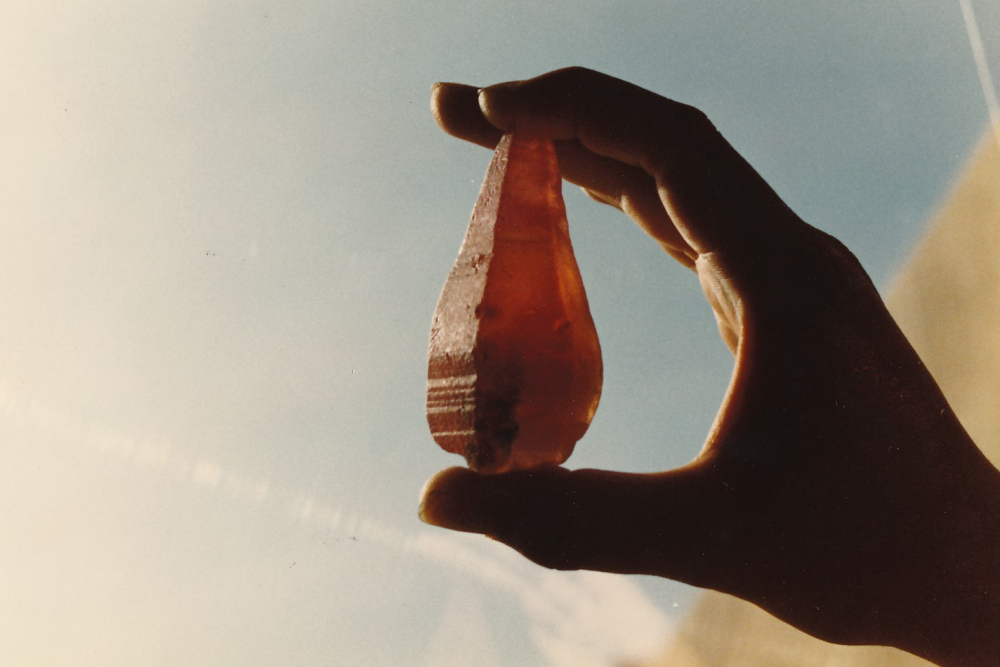Padparadscha is undoubtedly one of the rarest gemstones. The corundum variety, whose most important deposits are the gemstone placers of the island of Sri Lanka (Ceylon), represents a colour interplay of a warm, soft orange with a delicate pink tone. The origin of the name is still the subject of lively debate and no clear classification has yet been found. In Sanskrit, the ancient Indian literary and scholarly language, the name Padmaraja stands for the colour of the lotus blossom. However, the colour of the flower is not orange, but violet, blue, white, red, rose or pink. For centuries, sapphires with a colour consisting of a mixture of pink and orange have been called padmaraga (padma = lotus blossom and râga = colour) by the locals in Ceylon, now Sri Lanka.
 Spectacular padparadscha crystal from Sri Lanka. Photo: Company F. A. Becker, Idar-Oberstein.
Spectacular padparadscha crystal from Sri Lanka. Photo: Company F. A. Becker, Idar-Oberstein.
According to South Asian tradition, this very rare gemstone is “the ruler of the lotus blossom” and had to be given to the king because only he had the right to own them. Hence the name “King Topaz of Ceylon”, which finds mentioning in gemstone books from the first half of the 20th century.
 Left: Lotus blossom. Right: Sunset. Photo: U. Henn, DGemG.
Left: Lotus blossom. Right: Sunset. Photo: U. Henn, DGemG.
The ideal colour of padparadscha is described as a combination of the colour of the Ceylonese lotus blossom (pink) and the sunset (orange). This results in the international description of the colour as “pinkish-orange”. However, in Sri Lanka stones with a stronger pink than orange colour are often referred to as padparadscha as well.
It is important to clearly distinguish this rare colour combination from sapphire varieties that show a pure orange (without pink) or mostly brownish-orange. Such stones originate in most of the cases from deposits in East Africa, namely Tanzania and Malawi, as well as Madagascar. In terms of the causes of colour, orange in corundum is a mixture of red and yellow. The cause of the red colour component is trivalent chromium, while yellow can be caused by defect centres or trivalent iron. Yellow sapphires from Sri Lanka are coloured by defect centres and consequently the orange colour of the padparadscha from these classic deposits is due to an interplay of Cr3+ and defect centres. Yellow sapphires from East Africa (Tanzania and Malawi) and most stones from Madagascar owe their yellow colour to trivalent iron. Orange-coloured varieties are therefore caused by a combination of Cr3+ and Fe3+. Such stones generally do not have an evident pink component but display rather a brownish tint. Such corundums are referred to as orange-coloured sapphires in the trade and are thus distinguished from padparadscha.
The distinction between padparadscha and orange-coloured sapphires is made using absorption spectroscopy in the visual spectral range based on the absence or presence of Fe3+ bands in the blue/violet range.
 Brownish-orange coloured sapphire from East Africa (0.46 ct). Photo: T. Stephan, DGemG.
Brownish-orange coloured sapphire from East Africa (0.46 ct). Photo: T. Stephan, DGemG.
A padparadscha of extraordinary size is displayed in the Museum of Natural History in New York. The faceted stone weighs 100.18 ct and originates from Sri Lanka. Exceptional specimens weighing up to over 20 ct have been traded at auctions in recent years and have realised carat prices of over US$ 25,000. In 2005, as an example, an unheated padparadscha of 20.84 ct was sold at Christie's for US$ 374,400 or US$ 17,946/ct and in 2012 an unheated stone of 9.70 ct was sold at Sotheby's in Hong Kong for US$ 250,106 or US$ 25,784/ct.
Authors
Dr. Ulrich Henn & Dr. Tom Stephan, DGemG
© 2022
Literature
Ariyaratna, D. H. (2006): Gems of Sri Lanka.- 6th ed., Sri Lanka, ScanPlus.
Dharmaratne, P. G. R. (2005): Gem Industry of Sri Lanka.- The Geological Survey and Mines Bureau of Sri Lanka.
Lippelt, U. W. (2001): Padparadscha and/or Padmaraja.- Z. Dt. Gemmol. Ges. 50, 4, 228-230.
Picture of the Lotus blossom: pixabay.com/de/photos/lotus-blume-lotus-bl%c3%a4tter-614421/



